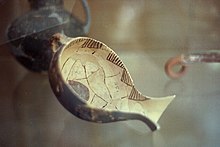Eutresis culture is a Final Neolithic and Early Bronze Age culture in mainland Greece, also known as Early Helladic I in Helladic chronology. [1] It was developed directly out of central and southern Greek Final Neolithic culture, and lasted roughy from c. 3200 to c. 2650 BC. [2]
The culture is named after the site of Eutresis (Boeotia), which was excavated in 1958. [3]

- Materials and architecture: stones, bones, clay objects and (rarely) metal are the main materials that were used in everyday life. A distinct fabric was employed for cooking vessels, which were normally dark surfaced. Several jars for storage and cooking have been discovered. Signs of fortifications have been discovered in Perachora area. It is believed that the vast majority of the houses were simple with one or two rooms. [4] [5]
- End: it was followed by the more advanced Korakou culture in Greece during the Early Helladic II period of the Early Helladic chronology in the first half of the 3rd millennium BC.
References
- ^ Pullen, Daniel (2008). The Cambridge Companion to the Aegean Bronze Age. Cambridge Univ. Press .
- ^ Early Helladic I Foundation of the Hellenic World
- ^ Caskey, John L.; Caskey, Elizabeth G. (1960). "The Earliest Settlements at Eutresis Supplementary Excavations, 1958". Hesperia. 29 (2). American School of Classical Studies at Athens (ASCSA): 126–167. doi: 10.2307/147291. ISSN 0018-098X. JSTOR 147291.
- ^ Rutter, Dr. Jeremy (4 January 2017). "The Eutresis and Korakou cultures of early Helladic I-II". Retrieved 5 September 2021.
- ^ Gschnitzer, Fritz. Η ιστορία της αρχαίας Ελληνικής Κοινωνίας (GR). Athens: Μορφωτικό Ίδρυμα Εθνικής Τραπέζης.
Eutresis culture is a Final Neolithic and Early Bronze Age culture in mainland Greece, also known as Early Helladic I in Helladic chronology. [1] It was developed directly out of central and southern Greek Final Neolithic culture, and lasted roughy from c. 3200 to c. 2650 BC. [2]
The culture is named after the site of Eutresis (Boeotia), which was excavated in 1958. [3]

- Materials and architecture: stones, bones, clay objects and (rarely) metal are the main materials that were used in everyday life. A distinct fabric was employed for cooking vessels, which were normally dark surfaced. Several jars for storage and cooking have been discovered. Signs of fortifications have been discovered in Perachora area. It is believed that the vast majority of the houses were simple with one or two rooms. [4] [5]
- End: it was followed by the more advanced Korakou culture in Greece during the Early Helladic II period of the Early Helladic chronology in the first half of the 3rd millennium BC.
References
- ^ Pullen, Daniel (2008). The Cambridge Companion to the Aegean Bronze Age. Cambridge Univ. Press .
- ^ Early Helladic I Foundation of the Hellenic World
- ^ Caskey, John L.; Caskey, Elizabeth G. (1960). "The Earliest Settlements at Eutresis Supplementary Excavations, 1958". Hesperia. 29 (2). American School of Classical Studies at Athens (ASCSA): 126–167. doi: 10.2307/147291. ISSN 0018-098X. JSTOR 147291.
- ^ Rutter, Dr. Jeremy (4 January 2017). "The Eutresis and Korakou cultures of early Helladic I-II". Retrieved 5 September 2021.
- ^ Gschnitzer, Fritz. Η ιστορία της αρχαίας Ελληνικής Κοινωνίας (GR). Athens: Μορφωτικό Ίδρυμα Εθνικής Τραπέζης.